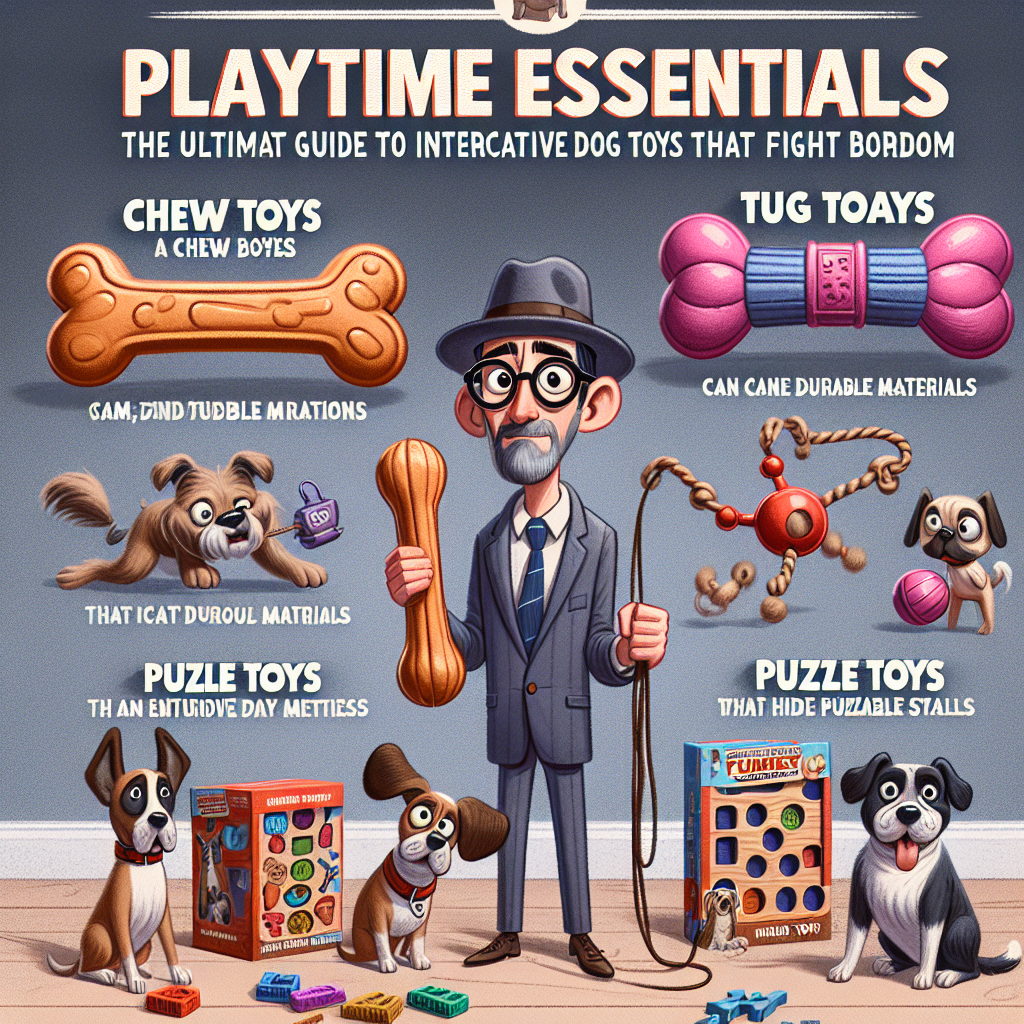
As a long-time dog lover, trainer, and companion to countless furry friends, I’ve seen firsthand how essential play is to a dog’s happiness and well-being. Interactive dog toys are a game-changer, not just to keep them occupied but also to stimulate their minds, prevent destructive behaviors, and strengthen your bond. This guide is packed with insights and practical advice, drawing from years of experience to help you choose the perfect toys and create a dynamic playtime routine for your canine companion.
Chapter 1: Why Interactive Dog Toys Matter
Understanding the Core Need for Playtime
Dogs, like humans, need mental and physical stimulation to thrive. Boredom can lead to a host of problems, from excessive barking and chewing to digging and even depression. Interactive dog toys address this issue directly. They challenge your dog’s problem-solving skills, encourage natural behaviors like hunting and foraging, and provide an outlet for pent-up energy.
These toys aren’t just about entertainment; they’re about enriching your dog’s life. A mentally stimulated dog is a happier, more well-adjusted dog. They’re less likely to engage in negative behaviors when their minds are occupied. Think of it as exercise for their brains, a crucial component for a healthy and balanced life.
The Long-Term Benefits of Mental Stimulation
Investing in interactive dog toys is an investment in your dog’s long-term health and happiness. Regular use of these toys can have several positive effects:
- Reduced Anxiety: Engaging puzzle toys can provide them with a sense of accomplishment, leading to a more relaxed demeanor.
- Improved Focus: The need to concentrate on a task provides them with a more improved attention span
- Enhanced Bond: Playing together strengthens the bond between you and your dog. Interactive play is a fantastic way to connect
- Slower Cognitive Decline: Just like humans, dogs benefit from mental exercise as they age.
- Prevention of Destructive Behaviors: A busy dog is less likely to chew furniture or engage in other unwanted activities.
Chapter 2: Types of Interactive Dog Toys
Puzzle Toys for Smart Canines
Puzzle toys come in various forms, from basic versions requiring dogs to slide or lift compartments to more complex designs that involve multiple steps and challenges.
- Level 1 Puzzle Toys: Great for beginners, these often involve sliding compartments or lifting flaps to reveal treats.
- Level 2 Puzzle Toys: Slightly more complex, these toys might require dogs to combine actions, like sliding a piece and then rotating another.
- Level 3 Puzzle Toys: These toys usually require multiple steps, such as pulling levers, sliding pieces, and rotating cylinders.
- Food Dispensing Puzzle Toys: These toys are a clever way to turn mealtime into a game, slowing down eating and providing mental stimulation. Some examples include treat-dispensing balls or puzzle feeders.
- Hide-and-Seek Puzzle Toys: These toys usually consist of plush containers with smaller squeaky toys hidden inside.
Toys for the Active Pup
Active playtime is also a crucial part of your dog’s well-being. Here are some options for dogs with lots of energy:
- Fetch Toys: From classic tennis balls to aerodynamic Frisbees, fetch toys are perfect for outdoor play and exercise.
- Tug Toys: These toys provide an outlet for your dog’s natural prey drive and allow for a fun, engaging game.
- Flotation Toys: If you have a water-loving pup, choose toys that float for fun in the pool or lake.
- Agility Toys: These toys can be fun for training, even in your own backyard.
- Laser Pointers: These are great to get your pup moving, can provide mental stimulation, and can be used to train your dog.
Toys for the Chew-Happy Dog
Even for dogs that have tons of chew-toys, those who enjoy chewing need toys that are durable and safe.
- Durable Rubber Toys: These toys can withstand serious chewing and are often designed to be filled with treats or peanut butter.
- Nylon Chew Toys: These toys provide a satisfying chew and can help clean teeth.
- Wood Chew Toys: These natural options can be safe and enjoyable for some dogs, but always monitor for splinters.
- Rope Toys: Great for tug-of-war and chewing, rope toys can help clean teeth as well.
- Frozen Toys: Some toys can be filled with water and frozen for a cooling, soothing chew.
Chapter 3: Choosing the Right Toys for Your Dog
Age, Breed, and Personality Considerations
Selecting the perfect interactive dog toys is about matching the toy to the dog – their age, breed, and individual personality all play a role. A senior dog might benefit more from a gentle puzzle toy, while a young, high-energy breed will thrive with a durable fetch toy or a more complex puzzle to keep them occupied.
- Puppies: Choose soft, safe toys made from non-toxic materials. Avoid small parts that could be swallowed.
- Adults: Consider tougher toys that can withstand more wear and tear. Vary the toys to keep your dog engaged.
- Seniors: Puzzle toys with easier difficulty levels and gentle physical toys are a good choice.
- Small Breeds: Opt for toys scaled appropriately in size and weight.
- Large Breeds: Choose robust toys that can handle powerful jaws and enthusiastic play.
Safety First: Material and Construction
Safety is paramount. Always inspect toys regularly for wear and tear. Replace damaged toys immediately.
- Non-Toxic Materials: Choose toys made from food-grade materials or those specifically labeled as non-toxic.
- Durability: Select toys built to withstand your dog’s chewing habits.
- Size and Shape: Ensure the toy is appropriately sized for your dog to prevent choking hazards.
- Regular Inspection: Look for signs of wear and tear, such as cracks, tears, or loose parts, and discard damaged toys.
Matching Play to Your Dog’s Needs
Consider your dog’s individual needs and preferences when choosing toys. Some dogs love to chase, others prefer to chew, and some are natural problem-solvers.
- Natural Chewers: Offer durable chew toys.
- High-Energy Dogs: Provide toys for fetch, tug-of-war, and agility.
- Smart Dogs: Engage their minds with complex puzzle toys.
- Dogs who love water: Choose toys with the ability to float.
- Dogs who love chasing: Select toys that can be thrown or that they can chase.
Chapter 4: How to Introduce and Use Interactive Toys
Making the Introduction Fun and Positive
When introducing a new toy, start by making it exciting. Place treats inside puzzle toys to encourage exploration. Use enthusiastic praise and encouragement.
- Initial Exposure: Let your dog inspect the toy and sniff it before initiating play.
- Treat Motivation: Use high-value treats to entice your dog to interact with the toy.
- Positive Reinforcement: Offer praise and rewards for correct behavior.
- Keep it Simple: Start with simple toys and introduce more complex options gradually.
- Supervision: Always supervise your dog during playtime, especially with new toys.
Engaging Playtime Strategies
To get the most out of your interactive dog toys, vary the playtime routine and strategies to keep your dog engaged.
- Rotate Toys: Keep the toy collection fresh by rotating toys regularly.
- Hide and Seek: Conceal treat-filled toys around the house for your dog to find.
- Puzzle Challenges: Increase the difficulty of puzzle toys over time.
- Training Integration: Use toys as rewards during training sessions.
- Game-Based Play: Make playtime fun and engaging by turning toy use into a game.
Troubleshooting Playtime Problems
Sometimes, your dog might not immediately take to a new toy, or they might lose interest quickly. Here are some tips to address these challenges:
- Lack of Interest: Try a different type of toy or add a novel scent (like a touch of peanut butter or a favorite treat).
- Frustration: If a puzzle toy is too challenging, start with a simpler one.
- Chewing the Toy Too Quickly: Offer a more durable toy or redirect the behavior with a safer alternative.
- Loss of Interest: Keep playtime short and sweet to prevent boredom.
- Too Aggressive: If your dog is aggressive, seek professional dog training guidance.
Chapter 5: Maintaining the Playful Lifestyle
Creating a Consistent Playtime Routine
Consistency is key to keeping your dog engaged and happy. Establish a playtime routine that fits your schedule and your dog’s needs.
- Daily Playtime: Aim for at least 15-30 minutes of interactive play each day.
- Scheduled Times: Schedule playtime to fit into your daily routine, such as before work, after dinner, or after walks.
- Variety: Rotate toys and types of play to keep things interesting.
- Observe Their Cues: Pay attention to your dog’s cues for interest and fatigue.
- Adjust to Life Changes: Be flexible with your playtime routine as your dog ages or as your lifestyle changes.
Beyond Toys: Expanding the Playtime Experience
While interactive dog toys are a great part of a dog’s playtime, don’t limit yourself only to products.
- Dog Park Visits: Social interaction is an important piece of development.
- Training Sessions: Use playtime as a reward during training.
- Nature Walks: Incorporate scent work and exploring new environments.
- Playdates: Arrange playdates with other friendly dogs.
- New Tricks: The biggest reward might be the new tricks your dog can learn.
The Lasting Impact of Play
Through dedicated play, you can cultivate a deeply trusting relationship with your dog and provide it with a fulfilling life. The simple act of play can boost your dog’s mental health and make it a well-adjusted companion.
- Stronger Bond: Consistent playtime deepens your bond.
- Reduced Stress: Play lowers your dog’s stress levels.
- Improved Training: Play makes your dog more receptive to training.
- Increased Happiness: A well-played dog is a happy dog.
- Lifelong Companionship: Play builds a lasting relationship.
Frequently Asked Questions (FAQs)
Q: How often should I replace my dog’s toys?
A: Check toys regularly for damage and replace them immediately. Durable toys might last months, while softer toys may need to be replaced more often.
Q: What if my dog doesn’t seem interested in interactive toys?
A: Try different types of toys, add treats, or use positive reinforcement and make the introduction fun. Sometimes, it takes a little experimentation to find the right fit.
Q: Are puzzle toys a suitable replacement for walks?
A: No, puzzle toys provide mental stimulation, but they do not replace physical exercise. Dogs need both mental and physical activity to stay healthy.
Q: Can I leave my dog alone with puzzle toys?
A: Yes, but begin by supervising play. Once you know your dog uses the toy safely, you can leave them with it.
Q: What are some signs that my dog is bored?
A: Look out for excessive barking, chewing, digging, or other destructive behaviors. Pay attention to cues or signals of the symptoms.
Q: What’s the main benefit of interactive toys?
A: These toys are very important for your dog’s mental health because they help keep your dog’s mind active and decrease the chances of the symptoms of boredom.
Instantly Access Your FREE Children’s Books Here!
Disclaimer: As an Amazon Associate, I earn from qualifying purchases. I may earn a commission from qualifying purchases as an affiliate. Please note that I only recommend products I believe will provide value to my readers.






